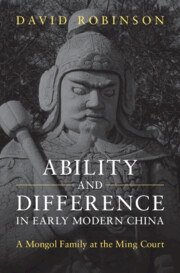Refine search
Actions for selected content:
136 results
Early Modern mercury production using ceramic vessels at Idrija, Slovenia
-
- Journal:
- Antiquity , First View
- Published online by Cambridge University Press:
- 05 December 2025, pp. 1-7
-
- Article
-
- You have access
- HTML
- Export citation
1 - The Limit of Afro-Mexico
- from Part I - Freedom and Colonial Legacies
-
-
- Book:
- Afro-Mexican Lives in the Long Nineteenth Century
- Published online:
- 20 November 2025
- Print publication:
- 04 December 2025, pp 35-62
-
- Chapter
- Export citation
Ottoman Justice and Political Economy of Empires: Venetian Merchants in Seventeenth-Century Ottoman Courts
-
- Journal:
- Comparative Studies in Society and History , First View
- Published online by Cambridge University Press:
- 21 October 2025, pp. 1-26
-
- Article
-
- You have access
- Open access
- HTML
- Export citation
3 - Examining the Doctrine of Art and Part in Early Modern Scotland
-
-
- Book:
- Law and Constitutional Change
- Published online:
- 26 September 2025
- Print publication:
- 16 October 2025, pp 44-62
-
- Chapter
-
- You have access
- Open access
- HTML
- Export citation
The Social Life of Wax in the Premodern Maghrib
-
- Journal:
- Comparative Studies in Society and History , First View
- Published online by Cambridge University Press:
- 13 October 2025, pp. 1-21
-
- Article
-
- You have access
- Open access
- HTML
- Export citation
Chapter 38 - The Atlantic and the Americas
- from Asia and the Americas
-
-
- Book:
- The Cambridge Guide to Global Medieval Travel Writing
- Published online:
- 03 October 2025
- Print publication:
- 02 October 2025, pp 672-685
-
- Chapter
- Export citation
Bad Grammar: Teachers, Crime, and the Law in Late Medieval and Early Modern England
-
- Journal:
- History of Education Quarterly / Volume 65 / Issue 4 / November 2025
- Published online by Cambridge University Press:
- 23 September 2025, pp. 517-535
- Print publication:
- November 2025
-
- Article
-
- You have access
- HTML
- Export citation
4 - Educating the Entitled
-
- Book:
- Ability and Difference in Early Modern China
- Published online:
- 10 September 2025
- Print publication:
- 11 September 2025, pp 82-114
-
- Chapter
- Export citation
9 - Turning Every Page
-
- Book:
- Ability and Difference in Early Modern China
- Published online:
- 10 September 2025
- Print publication:
- 11 September 2025, pp 212-230
-
- Chapter
- Export citation
3 - The Sovereign’s Man
-
- Book:
- Ability and Difference in Early Modern China
- Published online:
- 10 September 2025
- Print publication:
- 11 September 2025, pp 60-81
-
- Chapter
- Export citation
8 - Holding against the Storming
-
- Book:
- Ability and Difference in Early Modern China
- Published online:
- 10 September 2025
- Print publication:
- 11 September 2025, pp 186-211
-
- Chapter
- Export citation
7 - Patronage, Assessment, and Power
-
- Book:
- Ability and Difference in Early Modern China
- Published online:
- 10 September 2025
- Print publication:
- 11 September 2025, pp 163-185
-
- Chapter
- Export citation
Conclusion
-
- Book:
- Ability and Difference in Early Modern China
- Published online:
- 10 September 2025
- Print publication:
- 11 September 2025, pp 247-251
-
- Chapter
- Export citation
1 - An Age of Decisions
-
- Book:
- Ability and Difference in Early Modern China
- Published online:
- 10 September 2025
- Print publication:
- 11 September 2025, pp 23-40
-
- Chapter
- Export citation
10 - Seizing Fortune
-
- Book:
- Ability and Difference in Early Modern China
- Published online:
- 10 September 2025
- Print publication:
- 11 September 2025, pp 231-246
-
- Chapter
- Export citation
Introduction
-
- Book:
- Ability and Difference in Early Modern China
- Published online:
- 10 September 2025
- Print publication:
- 11 September 2025, pp 1-22
-
- Chapter
- Export citation
2 - Dying for His Lord
-
- Book:
- Ability and Difference in Early Modern China
- Published online:
- 10 September 2025
- Print publication:
- 11 September 2025, pp 41-59
-
- Chapter
- Export citation
6 - Far from Home
-
- Book:
- Ability and Difference in Early Modern China
- Published online:
- 10 September 2025
- Print publication:
- 11 September 2025, pp 138-162
-
- Chapter
- Export citation
5 - Representing the Emperor
-
- Book:
- Ability and Difference in Early Modern China
- Published online:
- 10 September 2025
- Print publication:
- 11 September 2025, pp 115-137
-
- Chapter
- Export citation

Ability and Difference in Early Modern China
- A Mongol Family at the Ming Court
-
- Published online:
- 10 September 2025
- Print publication:
- 11 September 2025
